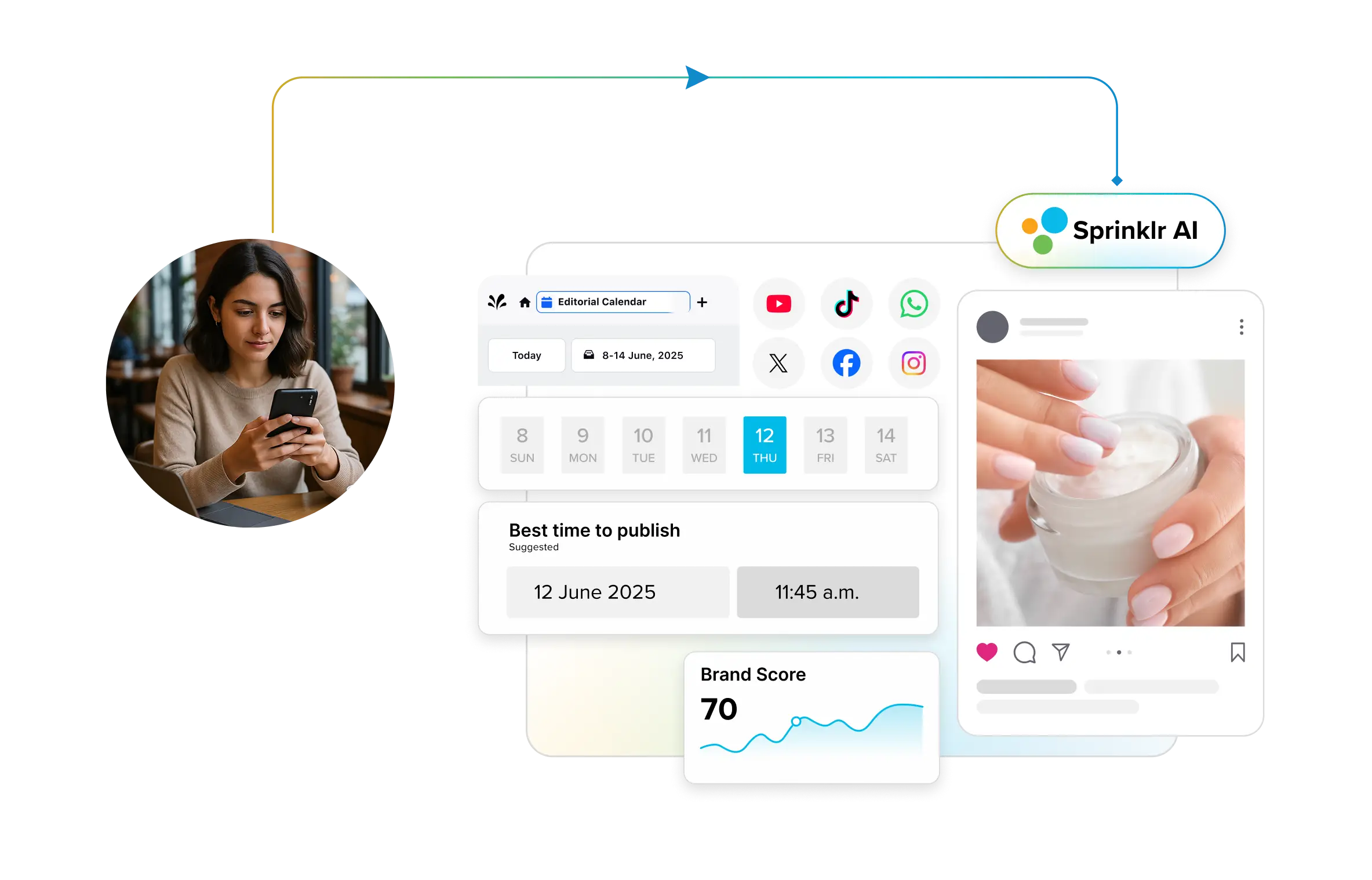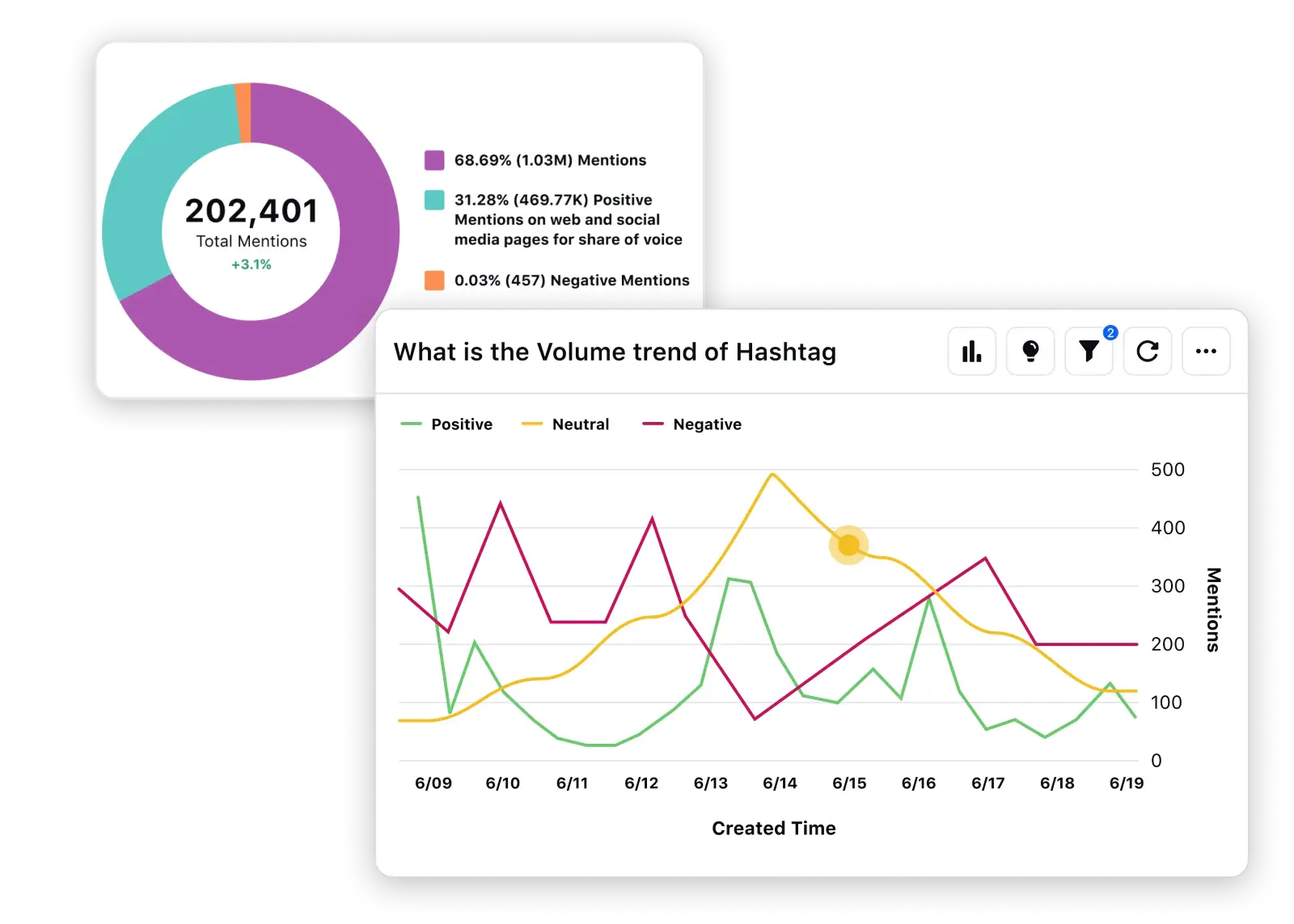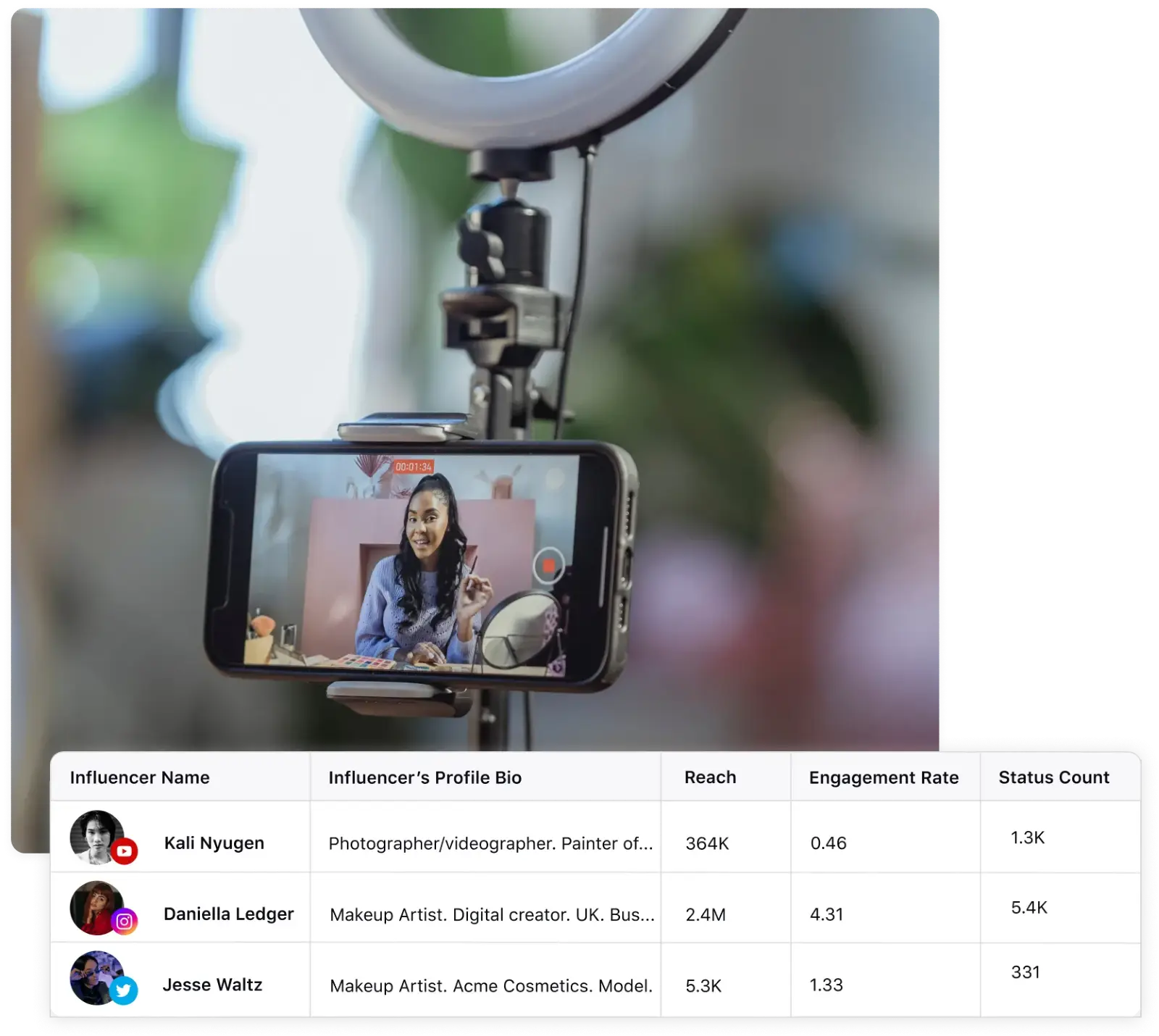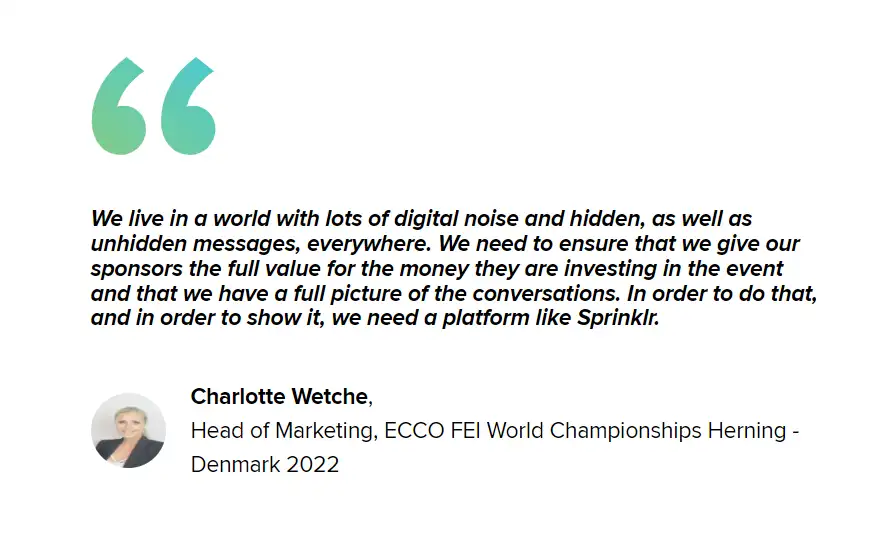The global leader in enterprise social media management
For over a decade, Sprinklr Social has helped the world’s biggest brands reimagine social media as a growth driver with a unified platform, industry-leading AI and enterprise-grade scale.

The Ultimate Social Media Management Checklist for 2024
How do you reach out to influencers? What should be the response time for DMs? How do you manage a social media crisis?
A comprehensive social media checklist can help you find answers to all of these questions and more!
91% of US marketers with companies larger than 100 employees use social media for marketing purposes. This makes effective social media management a key component of online marketing. But what does this involve? What should you watch out for? That’s where a social media management checklist comes in.
This blog will discuss the benefits and types of social media checklists. We’ll also cover strategies for creating a personalized checklist of your own. So let’s get right to it.
- What is a social media management checklist?
- Who should use a social media management checklist?
- Benefits of a social media checklist
- Types of social media management checklists
- Daily social media checklist
- Weekly social media checklist
- Monthly social media checklist
- 7 strategies for creating a personalized social media management checklist
What is a social media management checklist?
A social media management checklist is a structured list of tasks that help marketers maintain and build social media presence. It typically covers responsibilities like scheduling and creating posts, updating profiles and engaging followers, tracking and reviewing performance metrics and more.
But social media is constantly changing. So tasks should be divided based on their frequency. For instance, you don't need to create a content plan every day, but you should respond to comments daily.
Who should use a social media management checklist?
Various roles can leverage a checklist to manage social media. Here are three roles that require it the most:
- Small business owners: A social media management checklist streamlines tasks for small business owners. It helps them promptly respond to inquiries, maintain a consistent social media posting schedule and regularly monitor performance.
- Content creators: Content creators can leverage a social media management checklist to enhance their personal brand and grow their online presence. A good content checklist lets them focus on broader tasks instead of minute details.
- Social media teams: A social media management checklist helps enhance team collaboration and coordination. It ensures all team members know their responsibilities and deadlines, promoting an efficient workflow.
Benefits of a social media checklist
Social media checklists vary by platform and business type. A B2B brand might focus on sharing industry reports and engagement on LinkedIn, while a B2C brand may prioritize promotions and customer service on X (previously Twitter).
A well-structured social media checklist can improve various areas of social media management. Here are its key benefits:
Streamlines content posting
A social media checklist ensures that content is consistently planned, created and posted on schedule. This helps avoid last-minute confusion and maintain a steady flow of content, which is crucial for improving audience engagement.
Enhances monitoring and response
A checklist allows you to systematically monitor social media platforms and track social mentions, comments and messages. According to a study, around 28% of UK consumers expect a response on X (formerly Twitter) within 5 minutes. Businesses should strive to respond within this time frame.
Maintains consistency across platforms
Consistency in content and messaging across all social media platforms is vital for brand recognition and trust. A social media checklist helps ensure a uniform brand voice, style and posting schedules.
Let’s assume you are a fashion brand. A detailed social media checklist will help ensure your posts align with your brand’s aesthetics (like color palettes or fonts).
Facilitates better crisis management
A social media checklist includes protocols for handling negative feedback and crises, ensuring a structured approach during such events. This preparedness helps with social media crisis management by mitigating potential damage to the brand’s reputation.
Look at how Chipotle deals with food safety complaints. When customers complained about food hygiene, Chipotle’s X (formerly Twitter) team directed them to their website. This shifts their complaints from social media to a contact form for customer support or chatbot assistance.
Read More: How to manage crisis communication in 2024 (+ checklist)
Types of social media management checklists
Social media management checklists can be divided into daily, weekly and monthly activities. Let’s dive into them:
Daily social media checklist
Some social media tasks have to be done every day. Here are some of them:
1. Respond to comments and messages
A social media manager should respond promptly to comments and messages. This practice helps maintain customer satisfaction and shapes a brand’s reputation.
You need to respond fast. Fast replies show you value your customers and can prevent issues from escalating.
Here are the best ways to improve response times:
- Set up alerts: Utilize social media management tools to set up real-time alerts. This ensures that no customer query goes unnoticed.
- Designate a team: You might have many social media queries throughout the day, so create a dedicated team to respond to them.
- Create response templates: Develop a set of pre-approved response templates for common inquiries. This can speed up the response process while maintaining brand tone and consistency.
- Monitor and adjust: Regularly review your response times and adjust your strategies as required. This will help ensure efficiency and effectiveness.
2. Monitor brand mentions and related keywords
Quick action is crucial here to prevent damage to your brand's reputation. Here are a few steps:
- Track real-time mentions: Check social media regularly for brand mentions. This helps identify and address issues before they escalate.
- Monitor related keywords: Some users may mention your brand without tagging you directly. Active keyword tracking ensures you catch all relevant mentions.
🤔 How do you track brand mentions, though?
Uncovering brand mentions in the vastness of multiple social media channels can seem like a daunting task. But here’s where Sprinklr’s social listening software can help you keep your ear to the ground.
You can use it to:
📊 Capture relevant mention data from across billions of customer conversations across 30+ social and digital channels
🔎 Gauge the sentiment (positive, negative or neutral) of user conversations around your brand
🚨 Mitigate brand reputation risks by detect emerging issues and crises before they go out of control

3. Leverage trending topics and news
Nothing generates more consumer interest on social media than trending topics and news. FOMO is real! But how do you leverage that?
- Stay updated on trending topics: Check out the “Trending,” “Explore,” or “Discover” sections of social media apps to see what everyone is discussing. This will help you stay updated.
- Create related content: Create content that resonates with your audience. For example, a sportswear brand can boost visibility by creating posts about major sporting events that may be current, like the 2024 Olympics.
4. Engage with other accounts in your niche
Engaging with other accounts in your niche is crucial. This practice helps build relationships, increase your brand's visibility and establish your brand as a thought leader.
But how do you do that?
- Identity influencers: Start by identifying and finding key influencers, industry leaders and complementary brands in your niche. Look for ones with a strong social media presence among your target audience.
- Enable interaction: Regularly interact with their content by liking, commenting on and sharing their posts. This will help increase visibility.
- Consider creative collaborations: This will help amplify your reach and position your brand's credibility and authenticity. For instance, social media takeovers by influencers can bring new audiences to your brand.
Learn More: How to Find Influencers for Social Media: Top 8 Tips
Weekly social media checklist
Some tasks only need to have a weekly cadence. Here are the tasks you should prioritize:
1. Schedule content for the week
Planning your posts ensures a steady stream of content that keeps your audience engaged and informed. To get started:
- Create a content calendar: Outline your social media content calendar and plan key themes, promotions and events for the upcoming week. This will help keep everyone on the same page.
- Determine the type of content: It could include blog posts, videos or infographics you want to share. Aim for a balanced mix that caters to your audience's interests and aligns with your overall social media strategy.
Pro Tip💡: Keep your content calendar flexible. For instance, there could be a news item (such as a movie release or sports match) that you could piggyback upon to create an engaging social media post. Leave some slots in your content plan open for such opportunities.
Read More: Best Times to Post on Social Media for Better ROI
2. Review content strategy
Review your social media content strategy based on the previous week’s metrics. This process helps you refine your approach for better results. Here are the key steps:
- Collect relevant data: Start by collecting data from any choice of social media analytics tools. Key social media metrics to examine include engagement rates, click-through rates (CTR), conversions, reach and impressions.
- Identify performance patterns: Check for patterns in content performance, such as interaction types, audience activity times and top posts for traffic or sales. This will help you find out what resonates with your audience.
- Evaluate content effectiveness: Compare engagement metrics against your content calendar. Adjust your strategy based on themes, formats or topics that performed best.
Dive Deeper: How to Measure Social Media Engagement Effectively
3. Review and adjust ad campaigns
Regularly reviewing your ad campaigns is vital for maximizing their effectiveness and cost efficiency. Here’s how to get started:
- Examine key metrics: Start by examining key metrics such as CTR, conversion rates, cost per click (CPC) and return on ad spend (ROAS). This will give you a good idea of your paid social media efforts.
- Assess campaign effectiveness: Evaluate whether your ads meet your business objectives, such as driving traffic or generating leads. This will help highlight areas for improvement.
- Determine the factors affecting your strategy: These factors could be your targeting strategy or budget allocation. Based on your analysis, make the necessary adjustments, such as reallocating the budget or adjusting your targeting strategy.
A Key Read: Social Media Advertising: In-Depth Guide & Proven Tips (2024)
4. Assign responsibilities to team members
Schedule a meeting with all relevant team members, including those involved in content creation, community management, analytics and ad management. Here’s a step-by-step process:
- Prepare an agenda: It should include an overview of current social media goals, performance insights and specific tasks to be addressed. This will help you streamline the discussion.
- Outline responsibilities: During the meeting, clearly outline each team member's responsibilities based on their roles and expertise. Assign tasks like content creation, scheduling, monitoring and reporting.
- Discuss deadlines: Establish a timeline for tasks. This helps in setting clear expectations and ensures that everyone is on the same page regarding deliverables.
5. Identify and reach out to potential influencers and collaborators
Identifying and reaching out to potential influencers and collaborators is a key task in your social media checklist. This is how you can get started:
- Evaluate influencers and brands: Start by researching individuals and brands that align with your niche and target audience. Evaluate their influence based on metrics such as engagement rates and content relevance.
- Craft personalized messages: Reach out through professional channels and offer value, such as compensation or exposure. Highlight mutual benefits and propose clear collaboration ideas.
Pro Tip💡: Getting a hold of influencers who align with your brand might seem difficult. However, using an Influencer Marketing Platform, like Sprinklr’s, can make the process quick and easy. Not only does it help you find the right influencer for your brand and industry, but it also assists in tracking their performance and managing influencer campaigns across 30+ digital and social channels.

Monthly social media checklist
High-level strategy-oriented tasks are generally conducted monthly. Here is our list:
1. Develop a content calendar for the upcoming month
Developing a content calendar for the upcoming month is essential for maintaining your social media presence. This plan should:
Define content pillars
- Identify core themes: Define your content pillars, which are core themes that align with your brand’s objectives and audience’s interests. These might include industry insights, educational content, customer testimonials and promotional offers.
- Set strategic goals: Align each content pillar with specific goals, such as increasing brand awareness, driving engagement or generating leads.
Plan content types
- Maintain content variety: Plan a mix of content types for each pillar, including blog posts, infographics, videos and interactive posts. Such variety helps keep your audience engaged and caters to different preferences.
- Determine frequency: Determine the frequency of social media posts for each pillar. This approach helps maintain audience interest without overwhelming them.
Schedule events
- Include important events: Schedule content around significant dates, such as product launches, industry events or seasonal campaigns. This will help you stay relevant.
- Plan content timing: Plan the timing of posts based on the times your audience is most active based on historical data and analytics. This will increase visibility.
2. Analyze monthly performance metrics
Analysis of performance metrics should be a key part of your monthly checklist if you want to keep your content game strong. Here’s how you get started:
- Gather data: Begin by gathering data on social media KPIs (key performance indicators), such as engagement rates, reach, impressions and conversions from all platforms. This data will give you a broad understanding of how well your content and campaigns performed throughout the month.
- Analyze content patterns: Evaluate which posts and content types achieved the highest engagement and conversions and identify patterns or trends. Review campaign effectiveness by examining metrics like CTR and return on ad spend.
- Compare content performance: Compare your performance against the goals set for the month. This comparison lets you adjust your strategy and tactics to drive meaningful results.
3. Plan and coordinate influencer campaigns
Plan ahead to ensure that your influencer campaign is a hit. Here’s a quick rundown:
- Define clear campaign objectives: Start by defining clear campaign objectives, such as increasing brand awareness, driving traffic or generating leads via the influencer collab. Then, determine KPIs to measure the campaign's success.
- Create a detailed campaign brief: Outlining the campaign’s goals, key messages and deliverables. This brief should also outline content guidelines, timelines and brand-specific requirements.
- Develop a comprehensive campaign timeline: It should include pre-launch activities, content creation, publishing schedules and post-campaign evaluations. This will help you stay consistent from start to finish.
Related Read: Important social media guidelines for comanpies
4. Conduct a competitor analysis
Check out what your competitors are doing if you want to stay ahead of the game. Here’s how you can run a competitor analysis:
- Review top competitors: Review your top 10 competitors' social media activities to uncover effective strategies. This will help you spot trends you don’t want to miss.
- Analyze their content: Start by analyzing the types of content they post, including formats and themes. Evaluate their posting frequency and timing. Review engagement metrics, such as likes, comments and follower growth, to spot successful tactics.
- Evaluate their influencer partnerships: Analyze their influencer partnerships to understand their success. What types of influencers did they partner with, and what was the reach for collab posts?
Learn More: Your social media competitor analysis guide for 2024 and beyond
Use these insights to adapt effective strategies in your own social media plan based on your brand's objectives.
Bonus Read: Quarterly Checklist 🧐
- Audit all social profiles: Update bios, links, branding elements and profile pictures.
- Content compliance: Ensure all content adheres to platform policies and guidelines, such as community standards and copyright regulations.
- Crisis management review: Update guidelines, conduct a drill or review scenario planning with your team.
- Audience analysis: Understand your audience demographics and behavior and change your content strategy accordingly.
- Community management review: Evaluate engagement effectiveness, response times, interaction quality and follower feedback.
- Market analysis: Monitor industry news, conduct competitive analysis and monitor social media conversations to identify new market players.
- Training and development: Conduct relevant training sessions for the team.
- Social media budget realignment: Adjust the budget based on current needs, performance and goals.
7 strategies for creating a personalized social media management checklist
Creating a personalized social media management checklist is essential to meet business goals. Here are 7 key strategies:
1. Define your audience
Understanding your target audience is the foundation of a successful social media strategy. Create buyer personas that detail demographics, interests and behaviors.
2. Don’t be everywhere
Not all social media platforms are suitable for every business. Focus on platforms where your target audience is most active. For instance, if you're a home decor brand, focus on image-focused platforms like Pinterest rather than news-oriented ones like X (formerly Twitter).
3. Personalize engagements
Engagement should be authentic and tailored to individual interactions. Personalize responses to comments and messages to build stronger relationships with your audience.
4. Leverage social listening tools
Social listening tools help monitor brand mentions, industry trends and competitor activities. Use these insights to refine your content strategy and engage in relevant conversations.
Featured Customer Story
Herning2022 organizers used Sprinklr’s social listening to gain insights before, during and after the 2022 ECCO FEI World Championships.
Leveraging Sprinklr Social, they identified key questions, engaged with customers and discovered compelling stories. They also learned how to expand their reach to current and potential participants.

5. Analyze reach and performance
Regularly analyze the reach and performance of your social media content. Metrics such as engagement rates, reach and conversions provide insights into what’s working and what’s not.
6. Adapt your checklist to changing business needs
Customize your checklist to fit specific business requirements and objectives. For instance, if you're running a seasonal campaign, adjust your checklist to focus on campaign-specific tasks and deadlines.
7. Revise and optimize
Social media trends and business goals evolve. So revising your checklist regularly is important for optimizing your strategy.
Final thoughts
Checklists are crucial for consistent and efficient social media management. They streamline workflows, maintain content quality and ensure compliance with platform policies and brand guidelines. As social media evolves with new platforms and user behaviors, robust tools are essential for comprehensive management.
This is where Sprinklr Social, a platform with a holistic approach to social media management, can lend you a helping hand. Its key features include:
- Offers a unified dashboard: Manage all social media profiles from a single interface to simplify monitoring, performance and engagement.
- Supports consistent content delivery: Plan and schedule posts across multiple social platforms from a single place for consistent content delivery.
- Enables community management: Engage with followers effectively, ensuring timely and high-quality interactions.
Wondering how Sprinklr can help check all the boxes of your social media management efforts? Find out for yourself.
Frequently Asked Questions
Update your social media management checklist at least quarterly to ensure it aligns with current trends, platform updates, performance insights and business goals. Regular updates help maintain its relevance and effectiveness.
Yes. A well-designed social media management checklist can be adapted for multiple platforms, including platform-specific tasks and best practices. Consider each platform’s unique features to refine audience engagement strategies.
Prioritize tasks by their impact on your social media strategy and business goals. Focus on high-priority activities like content creation, audience engagement and performance tracking. Organize tasks by deadlines and urgency.
To measure the effectiveness of your social media efforts, include metrics such as engagement rates, follower growth, impressions, click-through rates and conversion rates.
A social media checklist aids crisis management by outlining predefined steps, such as monitoring negative comments, preparing response strategies and addressing issues promptly. It offers a structured approach to resolving crises, reducing potential missteps.






